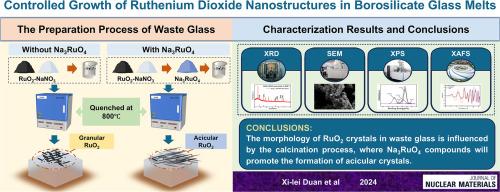Controlled growth of ruthenium dioxide nanostructures in borosilicate glass melts
IF 2.8
2区 工程技术
Q3 MATERIALS SCIENCE, MULTIDISCIPLINARY
引用次数: 0
Abstract
Ruthenium, a fission product generated during the fission of uranium oxide fuel in a reactor, interacts with alkali metals such as sodium in the upper layer of the cold cap, forming a sodium ruthenate intermediate (NaxRuyOz), which promotes the crystallization of acicular RuO2 within the glass melt. During vitrification, RuO2 predominantly settles at the bottom of the melt owing to its high density and low solubility, significantly increasing both the conductivity and viscosity of the glass melt. Herein, the formation of NaxRuyOz, along with the chemical reactions promoting the crystallization of RuO2 in the waste glass, was comprehensively investigated. The results of X-ray diffraction and X-ray spectroscopy indicate that lamellar and granular Na3RuO4 do not form directly through the reaction between NaNO3 and RuO2 but rather through an intermediate stage from Na2RuO4. This reaction critically affects the morphology of RuO2 within the waste glass. The uncalcined mixture of NaNO3 and RuO2 was found to interact with the glass melt, forming granular RuO2 crystals, whereas the reaction of Na3RuO4 with the glass melt was found to lead to the formation of acicular RuO2 crystals. The results of X-ray absorption fine structure analysis indicate that the valence state of Ru in NaRu-BSG is slightly higher than that in reference RuO2, which was attributed to the presence of trace amounts of Na3RuO4 in the glass.

硼硅酸盐玻璃熔体中二氧化钌纳米结构的可控生长
钌是反应堆中氧化铀燃料裂变过程中产生的裂变产物,与冷盖上层的钠等碱金属相互作用,形成钌酸钠中间体(NaxRuyOz),促进玻璃熔体中的针状 RuO2 结晶。在玻璃化过程中,由于 RuO2 密度高、溶解度低,它主要沉淀在熔体底部,从而显著增加了玻璃熔体的导电率和粘度。本文全面研究了废玻璃中 NaxRuyOz 的形成以及促进 RuO2 结晶的化学反应。X 射线衍射和 X 射线光谱分析结果表明,片状和颗粒状 Na3RuO4 并不是通过 NaNO3 和 RuO2 反应直接形成的,而是通过 Na2RuO4 的中间阶段形成的。这种反应对废玻璃中 RuO2 的形态有重要影响。研究发现,未煅烧的 NaNO3 和 RuO2 混合物与玻璃熔体相互作用,形成粒状 RuO2 晶体,而 Na3RuO4 与玻璃熔体反应则形成针状 RuO2 晶体。X 射线吸收精细结构分析结果表明,NaRu-BSG 中 Ru 的价态略高于参考 RuO2,这是因为玻璃中存在微量 Na3RuO4。
本文章由计算机程序翻译,如有差异,请以英文原文为准。
求助全文
约1分钟内获得全文
求助全文
来源期刊

Journal of Nuclear Materials
工程技术-材料科学:综合
CiteScore
5.70
自引率
25.80%
发文量
601
审稿时长
63 days
期刊介绍:
The Journal of Nuclear Materials publishes high quality papers in materials research for nuclear applications, primarily fission reactors, fusion reactors, and similar environments including radiation areas of charged particle accelerators. Both original research and critical review papers covering experimental, theoretical, and computational aspects of either fundamental or applied nature are welcome.
The breadth of the field is such that a wide range of processes and properties in the field of materials science and engineering is of interest to the readership, spanning atom-scale processes, microstructures, thermodynamics, mechanical properties, physical properties, and corrosion, for example.
Topics covered by JNM
Fission reactor materials, including fuels, cladding, core structures, pressure vessels, coolant interactions with materials, moderator and control components, fission product behavior.
Materials aspects of the entire fuel cycle.
Materials aspects of the actinides and their compounds.
Performance of nuclear waste materials; materials aspects of the immobilization of wastes.
Fusion reactor materials, including first walls, blankets, insulators and magnets.
Neutron and charged particle radiation effects in materials, including defects, transmutations, microstructures, phase changes and macroscopic properties.
Interaction of plasmas, ion beams, electron beams and electromagnetic radiation with materials relevant to nuclear systems.
 求助内容:
求助内容: 应助结果提醒方式:
应助结果提醒方式:


